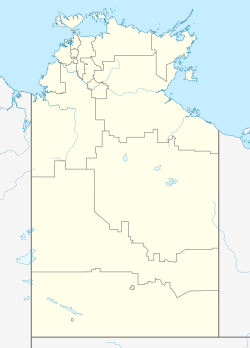Top Qs
Timeline
Chat
Perspective
Belyuen, Northern Territory
Town in the Northern Territory, Australia From Wikipedia, the free encyclopedia
Remove ads
Belyuen, formerly known as Delissaville, is a community in the Northern Territory of Australia located on the Cox Peninsula about 17 kilometres (11 mi) south-west of the territorial capital of Darwin.[1][3]
Belyuen consists of land under the control of the Belyuen Aboriginal community council. It is named after the Aboriginal community which was established with the name Delissaville and which was changed in 1975 to Belyuen which is the name of a “nearby waterhole.” Belyuen is classified as a community rather than as a locality because this is the standard Northern Territory Government description given to administrative areas that were established around the existing Aboriginal communities in 2007. Its boundaries and name were gazetted on 4 April 2007.[7][1][8]
The 2016 Australian census which was conducted in August 2016 reports that Belyuen had 164 people living within its boundaries.[2]
Belyuen is located within the federal division of Lingiari, the territory electoral division of Daly and the local government area of the Belyuen Shire.[5][7][4][8]
Remove ads
History
Summarize
Perspective
In 1881 G. T. Bean floated a company Adelaide and Port Darwin Sugar Company to establish sugar plantations in the Northern Territory. In 1882 he set up a trial sugar plantation on Cox's Peninsula (later Cox Peninsula) across Darwin Harbour from Port Darwin, and organised the hire of 2,000 Singapore Chinese labourers to work the field at £1 per week.[9] Investors included Benjamin Cohen De Lissa of Queensland (and after whom the Cox Peninsula suburb and town Delissaville (now Belyuen) and the nearby Delissaville airstrip were named), G. T Bean, W. H. Bean, Arthur Bean, Luther Scammell, George Scarfe and F. W. Stokes. Housing was erected, many cane tubers were supplied by the Government botanist M. W. Holtze from the nursery at Fannie Bay, many more ordered from Queensland and locally and a mill was erected by the Delissa Pioneer Sugar Company. DeLissa, who had been appointed supervisor for his sugar plantation experience, made a trial crushing of 30 tons of cane in December 1881 which returned very little sugar.[10] DeLissa quit in 1882, citing interference by G. T. Bean,[11] who was scathing in his denunciation of DeLissa.[12] W. H. Thompson was brought from Antigua to take over management of the plantations.[13] The machinery was bought for a tenth of its original £6,000 by W. H. Gray, for his Daly River Plantation Company but his plantation also failed, and it was left to rust away.[14][15] In 1885 the 100,000 acre lease was resumed for non-compliance with the conditions.[16] G. T. Bean was criticised for spending Adelaide and Port Darwin Sugar Company money on worthless land without due diligence, over-extending his stay in London and overspending his allowance there.[17]
Remove ads
References
Wikiwand - on
Seamless Wikipedia browsing. On steroids.
Remove ads
